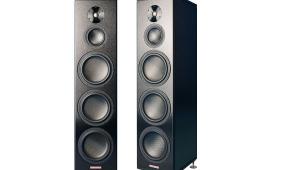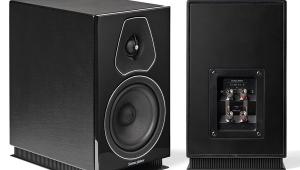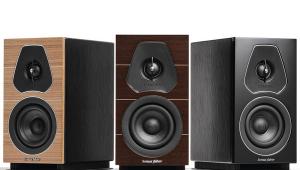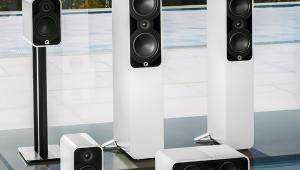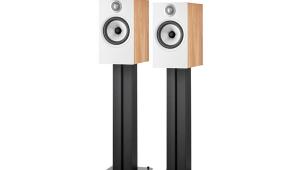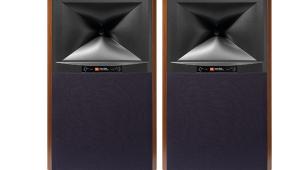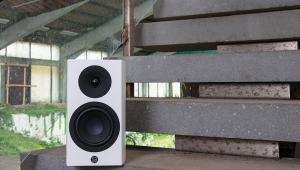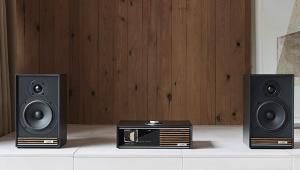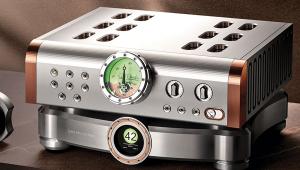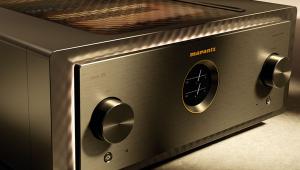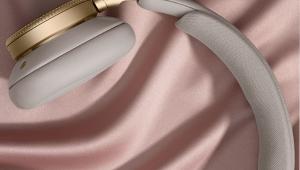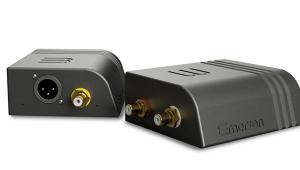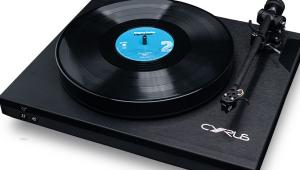Totem Arro - £2,025
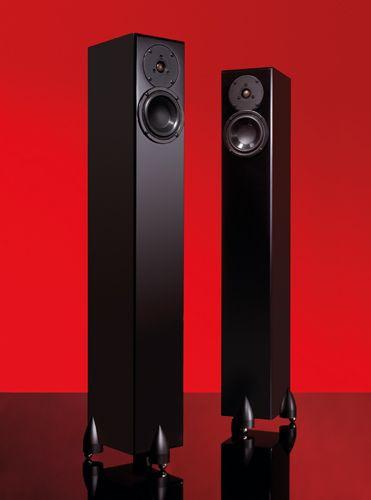
Well established Canadian manufacturer Totem takes its name from – and tends to name its models after – elements of that country’s First Nations culture, though quite where Arro comes from remains a little obscure. Perhaps it simply reflects the fact that the speaker itself is unusually straight and slim, albeit devoid of point or flights. Whatever, few serious speakers manage to look more discreet and self-effacing, especially in the highly reflective (and very fashionable) high-gloss black of our review samples.
The various high-gloss options sit at the £2,025 end of the price range, costing a very hefty premium over the regular veneered examples. However, these versions are also alleged to offer a worthwhile performance advantage (a claim we were unable to verify).
The very real difficulties of making an exceptionally discreet and compact floorstander, that retains adequate physical stability, are considerable The short version is that the small supplied plinth does help a little, but adding optional (not supplied) mass is really required if stability is an important issue.
The alternative (and claimed superior) fl oor-coupling arrangement involves a Totem accessory called a Claw, which sells in packs of six (three per speaker) for £330. These chunky solid aluminium pieces – one at the front, one at each rear side – again don’t do a great deal for the physical stability, but they certainly look good when installed and also hold the promise of lower enclosure coloration. A tripod is always superior to a four-spike arrangement in ensuring good fl oor contact and, in this case, the Claws use substantial steel ball bearings between themselves and the floor, ensuring a measure of decoupling as well as contact.
Small is Beautiful?Both the drive units used here are unusually small, factors that enable the front view to be exceptionally slim and which will contribute to a very wide dispersion. The tweeter has a 19mm doped-fabric dome and a relatively low frequency of fundamental resonance; part of its faceplate is cut away so that it may be mounted as close to the bass/mid driver as possible.
The main driver has a 114mm chassis and uses a cone of unspecified sandwich construction just 75mm in diameter. This bass/ mid driver is loaded by the uppermost part of the enclosure and a small reflex port, the latter tuned to around 52Hz. (There was some variation between our two samples here, one recording 50Hz and the other 54Hz for their respective port resonances.)
Neatly presented with gently softened and chamfered edges, the Arro weighs around 8kg, so it’s a quite lightweight affair,presumably deliberately so because low mass leads to low-energy storage. However, the enclosure construction leads to high stiffness and Totem is particularly proud of the fact that it uses mitred joints, a technique that considerably increases the surface area and hence the strength of the joints. Another unusual technique is the use of a borosilicate (glass) lining as a form of enclosure damping.
Gentle crossover filter slopes indicate that the Arro uses a minimalist network. This is hard-wired and fed from two pairs of terminals, so may be bi-wired or bi-amped if the brass links are removed.
Subjective SurprisesAs with other Totem speakers previously encountered, the Arro has a few surprises up its sleeve. Despite the small enclosure and main drive unit, room measurements indicated that the Arro was best placed well clear of walls, because the port tuning frequency coincides with a prominent mode in our listening room.
Another unexpected and impressive feature is that the sound shows quite superb consistency, irrespective of the position of the listener in relation to the speakers. This is unusual for a speaker with gentle crossover slopes and consequent wide driver overlap, attesting to the considerable refinement of the crossover network.
Such a very compact speaker inevitably has some limitations in terms of bass weight and loudness capabilities, but within those constraints this is a quite loudspeaker that does nearly everything else exceptionally well. The beautifully neutral, smooth and well-judged tonal balance is probably the most obvious feature, but the low enclosure coloration and fine stereo imaging are equally worth mentioning.
The bass might not be the deepest or most even around, but it remains agile and well timed, and the fact that it can provide a decent degree of punch when required makes it more convincing than the bare ingredients might tend to suggest.
Claws outWe were quite sceptical that replacing the little plinth with the Claws would make much difference and it, therefore, came as a rather pleasant surprise to find that they really do work, successfully ‘cleaning up’ the sound and removing some residual ‘thickening’ coloration in the upper bass and lower midband.
The Arro is perfectly acceptable when used with its regular plinth, but on the end of a high-quality 500-series Naim system, the Claws certainly demonstrated a worthwhile advantage. A key strength of this speaker lies in its fine delicacy; incorporating the Claws simply improves the performance.
The bottom line is that the Arro has an excellent dynamic range, so that delicate and subtle low-level information comes through without obstruction, yet at the same time dynamics themselves are vigorous and realistic, albeit without quite the grip and drama of larger speakers.
Indeed, the only thing that’s obviously lacking here is a measure of authority and gravitas, which is only really noticeable with certain forms of music – organ, large scale orchestral and heavy rock or dance material. Even these don’t exactly upset the speaker, it’s just that the Arro doesn’t quite do them full justice.
While it’s certainly true that many significantly larger floorstanders are available for much lower prices, that doesn’t mean that they offer a superior musical performance. In fact, the Arro justifies its not inconsiderable price through the sheer subtlety of its all-round performance, which essentially combines the very real advantages of a miniature standmount with the extra bass heft and aesthetic elegance of an ultra-compact floorstander.
It’s not exactly the perfect loudspeaker – the pair matching and dynamic drama might have been better – but precious little else merits criticism. And the fact that it’s such an attarcative little speaker is a major bonus.
LIKE: Sweet and smooth sound, with superb voiceband coherence
DISLIKE: Quite costly for a speaker with limited bass weight and authority
WE SAY: This very compact speaker is sonically very refined, with brilliant vocal expression and coherence
PRODUCT:
Totem Arro
ORIGIN:
Canada
TYPE:
Floorstanding twoway
loudspeaker
WEIGHT:
4.5-9kg
DIMENSIONS:
(WxHxD)
130x850x180mm
FEATURES:
• Reflex bass loading
via small rear port
• 19mm doped-fabric
dome tweeter
• 114mm bass/
mid driver with
sandwich cone
• Two pairs of chunky
multi-way terminals
• 2.4kHz hard-wired
crossover
• Choice of real
wood or high-gloss
painted finishes
• Supplied plinth
• Optional ‘Claws’
(£330)
DISTRIBUTION:
Joenit BVBA
TELEPHONE:
07740 284459
WEBSITE:
totemacoustic.com
 |
Inside this month's issue:
Pro-Ject Debut EVO 2 turntable, Advance Paris sub-£500 X-i50 BT integrated amp, DALI's stunning Rubikore standmount loudspeakers, Triangle Capella wireless active speakers, EAT's Fortissimo turntable with F-Note tonearm, our headphone Group Test and much, much more... |

